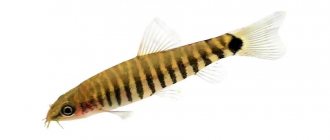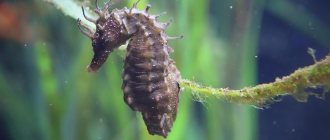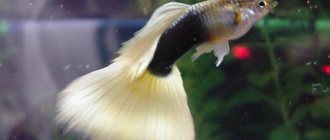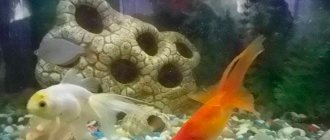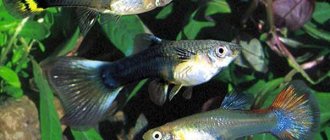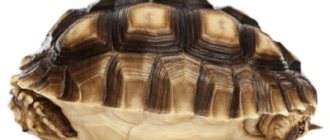Marbled botia (Botia almorhae, Botia lohachata), otherwise Lohakata botia, Almora botia, in English Pakistani loach (Pakistan loach) is a freshwater aquarium fish of the loach family, belongs to the genus of botia.
In nature, it is distributed in the waters of the Ganges and related standing water bodies of India and Bangladesh.
At the moment, there is no exact classification of bots. The northern variety has a pale color. Is it one type or different - the question is debatable.
Kept in aquariums since 1912. In European countries - since the mid-50s of the last century. It has been known to Russian aquarists since the 2000s.
Description
Due to the presence of whiskers, they are mistakenly classified as catfish, although the bots belong to the order Cyprinidae. They are similar in the manner of sleeping vertically and on the side, by digging the soil. The lohakata differs from the catfish in the presence of scales, peaceful behavior, and the absence of lungs.
Appearance
The body is elongated, the abdomen is flat, the back is curved. The caudal fin is forked. In an aquarium it grows up to 100–150 mm. The head is small, pointed in front. The mouth is small, sloping down. 6 pairs of antennae on the upper and lower jaws. Used to search for food at the bottom.
The scales are small and covered with mucus. The skin is easily scratched.
Spikes are hidden under the eyes. The spikes are released with a click when there is danger.
The color of the body and fins is light silver with dark gray or black patterns. The patterns are similar to the repeating "Yo" symbols, earning the fish the nickname "YoYo loach".
Behavior
Shows aggression when kept alone. Therefore, keeping 3–6 fish is recommended. Stick together. The flock is aggressive in an overcrowded aquarium. In conflicts, they do not injure each other. They do not show predatory instincts.
When frightened, he “turns pale.” The patterns on the skin take on a light gray color. Pretending to be dead.
Bottom fish. Cleaner picking up drowned food. When there is a lack of plant food, it eats plants. Loosens the soil. Digs up plant roots.
View this post on Instagram
#botsia how bae says to you: “good night???” #marble botia #botiaalmorhae
A post shared by gvrax (@gvrax) on Jun 2, 2021 at 11:09am PDT
It eats snails, gnawing them out of the shell.
She moves a lot, is nocturnal, and is curious. During the day it hides in dark places and shelters. Sleeps on the side or head up.
Before rain, it increases activity: in wild conditions, rain streams wash insects and worms into the water.
Lifespan
In an aquarium it lives 6–8 years.
Compatibility
As a rule, marbled bots get along well with other types of fish, but aggressive and predatory ones should be avoided. If they feel in danger, they will spend most of their time in shelters and may even refuse to feed.
Although they do not complain about lack of appetite. It cannot be said that they also get along well with each other, but in a pack the alpha male establishes dominance, sometimes chasing other males.
However, these fights do not end with serious injuries.
It is good to keep marbled ones with related species, for example, clown botia.
Content
The size of the aquarium, the quality of water, maintenance and care affect the growth and behavior of bindweed.
Aquarium
For one individual, choose a container from 0.1 cubic meter. For three - from 0.2.
Water parameters
- Water temperature is 24–28°C. With intensive ventilation it will withstand 30°C.
- Hardness - 6–12°.
- Acidity - pH 6.5–7.5.
Keep the water clean: marble bots raise turbidity. Water circulation with the organization of currents and filtration are required. Biofiltration is recommended. Change at least a third of the water weekly and clean the bottom of excrement. Siphon off leftover food constantly. Loaches do not feel full and are prone to overeating, which can lead to obesity and gastrointestinal diseases.
Plants
Lohakata gnaws the leaves of plants, so choose hard-leaved ones.
- Anubias.
- Cryptocorynes.
- Congo fern.
- Crinum calamistratum.
Plant in pots, or protect the roots of plants with flat stones.
Disadvantages of hard-leaved plants:
- sluggish growth;
- overgrown with algae;
- expensive in stores.
Consider purchasing artificial plants.
Priming
Botia tears up the soil in search of food. By burrowing, it removes excess mucus from the scales. Pour in small round pebbles: the sharp fragments will injure the fish’s skin. Add large stones without sharp corners - they will serve as a shelter.
Decorative elements
They serve as shelter for bindweeds. Make a grotto out of stones. Driftwood, plastic and ceramic tubes, sleeping cups, and houses are useful. Holes of sufficient diameter will get stuck.
Equipment
- Heater with thermostat to maintain stable water temperature, thermometer.
- Compressor for aeration and air supply of the internal filter. The internal compressor is silent, but it will have to be hidden. Harvesters for sale include a filter and compressor arranged in a monoblock.
- External filters are designed for aquariums with a capacity of 200 liters or more.
- The biofilter is designed to neutralize harmful substances dissolved in water. The main enemy of fish is ammonia, which is formed from rotting organic matter. Risks of nitrate poisoning. Bacteria in the filter convert the ammonia into a safe composition. Purchase or do it yourself.
- Siphon for cleaning the bottom.
- Top cover: the botia can jump out.
- Net.
- Scraper for removing algae from the walls of the aquarium.
Lighting
Lighting is standard. Calculate the lamp parameters using the Calculator on the Internet. Cool and economical LED and fluorescent lamps are preferred.
Feeding marble bots
Marble botia photo
The marbled botia is practically omnivorous - although it prefers protein food, it will not miss the opportunity to feast on fresh vegetation. Bots have almost no sense of satiety, so you need to be very careful in feeding - these eternally hungry goblets will eat until they burst or die from obesity. By the way, the gastronomic predilection of marbled loaches for small snails (coils, fisa, melania) makes these fish almost unsurpassed orderlies in the aquarium. They are capable of reducing the population of small unwanted mollusks and crustaceans to almost zero in a few days. In order to protect young shoots of greenery in planted aquariums, it is best to regularly, at least once or twice a week, feed Yo-Yo with fresh cucumber or scalded spinach, fixed to the bottom with pebbles or simply on a stainless steel fork. Dry granulated food for aquarium fish is also perfect, but only the kind that sinks and lies on the ground; the lohakat cannot and will not want to take food from the surface and from the water column. When feeding, you should always remember the unshakable rule of the aquarist: “it is better to underfeed than overfeed.” It is best to feed marble bots at sunset, that is, shortly before the main lighting turns off.
The diet of bots in nature is extensive. In fact, they eat everything - insects, larvae, worms. For an aperitif, they can chew a stretchy drink. Therefore, in aquarium conditions, their feeding should be varied and contain both protein and plant ingredients. Bots will calmly pick up any food that reaches the bottom - flakes, granules, sticks. But if we talk about personal feeding, it is best to use tablet food, such as Tetra Wafer Mix.
Food for bots from Tetra
Please note that it is not worth buying food tablets for loriks , such as Tetra Pleco Tablets. Such food consists entirely of plant ingredients. The boys will not approve of such a choice.
Reproduction
There are no confirmed cases of reproduction at home. Carried out by specialists. In amateur aquariums, the female spawns and lays eggs. The male does not fertilize. A common case is the impossibility of marking and the death of the female.
Sex differences
Females are larger, the abdomen is slightly rounder. Males have slight redness near the whiskers and the edges of the mouth.
Spawning
The inducement to spawning is separation of the pair, feeding with plant food. When transplanting into a spawning aquarium, stimulating injections are given. Spawning aquarium - from 150 liters. Water temperature - 29–32°C, intensive circulation and filtration. Acidity – pH 6.5–7, hardness – 4–6°.
Marking and fertilization occur at the surface of the water. At the end, the parents sit down to preserve the eggs.
After a day, the larvae appear. After three days, they begin feeding with “live dust”, phytoplankton, and microworms. From the age of 10 days - add fortified dry food for fry, nauplius, daphnia.
Breeding
Reproduction of a species in an artificial ecosystem is a difficult task. The option of using hormonal drugs is effective, but it requires many years of experience, so you can try to stimulate individuals to spontaneous fertilization.
For 3-5 days you need to place the male and female in different aquariums, leaving only plant food in the diet. Next, the individuals are sent to a spawning tank with a capacity of 150 liters or more. Its bottom must be equipped in advance with pebbles and a mesh for separation. Measures to stimulate spawning:
- temperature rise up to +30 °C;
- replacing 1/5 of the volume with distilled water;
- imitation of a strong current thanks to the operation of a filter with a powerful pump.
As a result, the male, using his pectoral fins, helps the female reach the surface, where the main stage of reproduction begins. The result is 3-5 thousand eggs. Unfertilized ones that have a white tint should be removed from the spawning tank.
After the eggs appear, the adults return to the original aquarium, as they tend to eat the offspring. The fry are formed within one week.
At the beginning of breeding, they are fed with daphnia and rotifers, which helps them grow without delays.
Diseases
Marbled bots are not resistant to diseases. Of the entire community aquarium, only the bots can get sick, while the rest of the fish are feeling normal. They do not tolerate copper sulfate and malachite greens.
Ichthyophthiriasis (“semolina”). Damage by ciliate parasites. Introduced by new inhabitants, with low-quality food. Appears in the form of white tubercles on the scales. Treating it yourself is risky. Contact an ichthyopathologist.
Bacterial infection of scratches. Manifest in the form of ulcers, inflammations, spots. Treat with Sera Baktopur, Sera Baktopur direct, Ektol, Tsifran according to the attached instructions.
Diplostomatosis (helminthic cataract). Parasitic damage to the eye by larvae of digenetic flukes. Symptoms: clouding and swelling of the eye. Spread by shellfish and objects from natural bodies of water. Contact an ichthyopathologist.
Carp rubella. Bacterial or viral infection. Symptoms resemble nitrate poisoning. Perform ammonia and nitrate tests. Red spots (hemorrhages) on the body, bulging eyes, dropsy, ulcers. Treated with interferon from a pharmacy (1 ampoule per 30–40 liters of water) together with Sera Baktopur direct. The biofilter will not work due to medications.
Disease prevention: any addition to the aquarium goes through a 40-60 day quarantine. Quarantine aquarium with a volume of 60–80 liters with its own equipment.
Habitat in nature
Marbled botia was first described by Narayan Rao in 1920. It lives in India and Pakistan. Its habitat is quite wide and is not under threat from industrial enterprises.
It lives in places with low currents or in stagnant water; we can say that it does not like currents. Backwaters, lakes, ponds, oxbow lakes are the typical habitats of these fish. They feed mainly on insects, but can also eat aquatic plants.
In English the species is called “yo yo loach”. The origin of the name comes from a famous photographer named Ken Childs, who has been working in the aquarium industry for over 20 years.
When he was photographing fish for the next report, he noted that in some individuals, the blossoms merge into letters reminiscent of YoYo.
In the article he mentioned this name, it was easily remembered and caught on with the English-speaking audience.
Reviews
The reactions of aquarists to the acquisition of lohakat are contradictory. Optimists are pleased with the interesting and peaceful behavior, the advantages of a cleaner, and the original color.
Pessimists accuse the fish of aggression, eating plants and young shrimp. Eating snails is not considered a disadvantage.
How does he get along with other fish?
Despite its size, if the maintenance rules are followed, Lohakata exhibits a peaceful nature, so it can be shared with many popular species.
It is important to know! The fish is very aggressive if kept alone or in small groups (2-3 individuals). It is dangerous for small fish (for example, Guppies) or individuals with veil fins (Goldfish, Bettas).
In general, any other species of Botia or comparable species that live in the middle or upper layers of water will be the best neighbors. By the way, among all varieties of Botsy, Clowns are considered the most popular fish.
Photo
How to choose the right Lohakata when buying, what to look for?
When purchasing a Lohakat, you must carefully evaluate its condition and behavior.
First of all, it is recommended to take sufficiently strong fish that have reached 5 cm in length. Individuals should not be thin, sunken, lethargic or slow. It is worth examining the skin especially carefully: there should be no ulcers, spots, especially small white dots on it. The so-called “semolina” is the most common disease that affects fry and young bots.
Some buyers are sometimes confused by Lohakat's behavior, since they are more active in the dark, and during the day they can simply sit out in protected places. To look at the behavior of the fish, ask the seller to pour at least a little food. Marbled Botia have a very good appetite and always come out of hiding when food appears.
Even if you are sure that you have purchased healthy pets, they still cannot be immediately released into a common aquarium. To protect other fish, Lohakata should be kept in a separate container (quarantine) for 3-4 weeks. If the recommended precautions are followed, Marbled Botia will delight the owner for a long time with its unusual coloring and active behavior.
Other shapes and similar species
Under the general name “Marbled botsia,” two species of fish are united - B. Lochata and B. Almorhae, which even scientists find difficult to distinguish from each other visually. For example, the color of specimens caught in Pakistan is somewhat paler than the color of Indian fish. Perhaps these are completely different subspecies or even species.
In addition to marble ones, there are several other types of bots. The most common are chess and clown botsiya. The latter are distinguished by a characteristic bright orange color of the body, through which wide wedge-shaped stripes pass. In the wild, clowns grow up to 50 cm, in an aquarium - up to 26 cm.
Botia the clown is a real long-liver. Under artificial conditions, life expectancy is up to 20 years.
Chess fighting dogs are a fairly new inhabitant of the aquarium. They were first described only in 2004. They have an elongated body with a straight abdomen and an arched back. The body is dark blue with a purple tint, with light spots of varying sizes running along the body. The size of an adult is up to 10 cm.
Interesting Facts
- The color of the marbled botia noticeably fades when the fish is very frightened. Sometimes the stripes on her body merge with the background of the aquarium, and she becomes completely invisible.
- In case of danger, the marbled botia can pretend to be dead if it does not have time to hide in cover.
- It has been noticed that before the rain, marbled borers become more active. According to the observations of aquarists, these fish are able to “predict” rain quite accurately.
- Contrary to popular belief, marble botia is capable of making sounds similar to clicks.
Sexual Dimorphism
There are no pronounced gender differences.
Females are slightly larger and their abdominal line is more rounded. Males usually have redness around the antennae and mouth.
Diseases
How long do warriors live? Under good and high-quality conditions, they can live up to 5-8 years. But there are exceptions when fish live up to 16 years. However, the life expectancy of a lohakata can be significantly reduced if certain diseases are not prevented in time. Let's look at the diseases that marbled botia can get.
- Ichthyophthiriasis is a disease characterized by small white bumps that resemble semolina. Another name for this disease is “semolina”. The source of this disease is ciliates; it can be brought in with low-quality food.
When the disease is detected, the water temperature should be increased a few degrees. If the disease is at an advanced stage, consult a specialist.
- Stress - can be caused by a change in situation or environment. Because of this, the fighting can rush from side to side. To avoid this, fish should be introduced into a new aquarium with the lights turned off. Then in the dark it will be easier for them to adapt to new conditions and explore their environment.
- Weight loss – The cause of weight loss is considered to be the occurrence of flagellated parasites of the genus Spironucleus. To cure this disease, the fish should undergo a course of treatment with antibiotics such as Levamisole and Panacur.
Features of behavior
Botsia are rather shy fish, but at the same time very curious. They are almost always friendly towards their neighbors, only sometimes they may conflict in the fight for shelter or food in the aquarium. Therefore, it is important to fill the container with all kinds of aquatic plants, driftwood and stones where the fish can hide. Pakistani women love to explore the scenery, but they rarely sleep in it. Due to their excessive activity, these fish often fall asleep while walking.
Marbled fish are considered to be more active at night and during twilight, so it can be argued that individuals extremely dislike bright light. During the day, the botia mainly hides under snags, between large stones, and also in dense thickets of algae. The preferred location for these fish is the lower layer of the reservoir. Less commonly, individuals in their natural habitat swim in the middle layers.
The homeland of the marbled botia is Indian and Pakistani reservoirs.
The Pakistani woman eats food from the bottom. The fish live in schools, so it is recommended to keep at least 6 of them in the aquarium. Then the individuals will feel more calm. Living alone, the fighting creatures behave more aggressively and are almost constantly in remote shelters.

